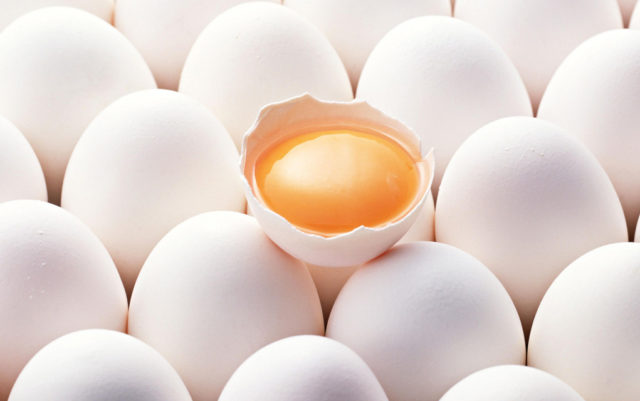
A few years ago, the humble egg went through a public relations nightmare. Blemished with the falsehood of causing high cholesterol, eggs scared many people away. Health seeking consumers eschewed the nutritious yolk, favoring the boring, flavorless white, if they ate eggs at all. A sad sight.
Then, along came a Harvard School of Public Health study, stating that the dietary cholesterol in eggs did not raise cholesterol levels in the majority of the population and found no association with heart disease. Slowly, like the picked-on kid in elementary school who grows up to be a tech billionaire, eggs became popular. But not without adding more confusion. We’re now faced with a multitude of choices from Cage-Free to Pastured to Omega-3, a morass of labeling that can be confusing and many of the monikers mean nothing. But they capture your heart and money. To clear up the pasture, here’s the skinny on eggs.
The Nutrition Breakdown
One whole egg weighs in at 6 grams of protein, around 70 calories and heaps of vitamin B12, A, E and lutein (good for the eyes), as well as minerals such as iron, selenium and calcium.
How to Shop for and Store Eggs
• Buy in bulk. Eggs stay fresh about a month after you bring them home, usually long after the sell-buy date is past. Keep them in the middle of the refrigerator, not in the door, to retain their freshness.
• The color of the shell only indicates the variety of chicken the eggs came from, not the quality.
• Keep ‘em cool. An egg stored for an hour at room temperature will age faster than you waiting in line at the DMV.
• Use older eggs for hard boiling. Hard-boiled eggs keep for up to a week in the fridge.
• The fresher the egg, the cloudier the egg white will be since it contains carbon dioxide after harvesting. The white of an older egg will become more transparent once the CO2 escapes through the shell. Born on dates help at the store, but this will help you determine the age of of the dozen once it’s home.
• What the hen is fed determines the color of the yolk. Look for a darker yellow hue, which indicates a more natural diet, rather than industrial grain feed.
The Labels, Revealed
The Helpful:
• “Free-Range” means that hens live outside of cages and must have access to the outdoors. It’s not mandated how much access, so that’s up to the farmer. Want a clear conscious? Buy local and get to know or research the farmer you’re buying from.
• “Cage Free” indicates the hen can roam about indoors but do not have access to the outdoors. They can spread their wings, nest and do other chicken things. But, in this instance, their diet consists of what the farmer gives them rather than pecking about outside for stuff in the dirt. This means less flavor and nutrition.
• “Certified Organic” meets the standards of the U.S. Department of Agriculture (USDA) organic program and the birds must be cage-free with outdoor access, given no antibiotics, and their food must be organic and vegetarian.
• ‘Omega-3’ or ‘DHA’ eggs are produced by hens that are fed high amounts of omega-3 fatty acid food like flaxseed. Check the packaging to make sure DHA and EPA are included in the fatty acids, those linked to heart health.
• “Certified Humane” ensures that the chickens live uncaged with room for nesting and perching. The nonprofit organization Humane Farm Animal Care works with the USDA to inspect and certify farms.
• “Animal Welfare Approved” is a label created by the Animal Welfare Institute to indicate the eggs came from an independent family farm with flocks of up to only 500 birds, where the hens spend as much time as they want in pasture and have never had their beaks altered (this sometimes occurs in chicken houses that are overcrowded).
The Virtually Useless Label Fodder:
• “Fed a Vegetarian Diet” doesn’t mean much since the majority of time, chickens are fed grain products.
• “Hormone Free” is the same since chickens are rarely treated with hormones (unlike beef cattle).
• “Natural” only means that the egg contains no artificial flavors or colors. Duh.
• “United Egg Producers Certified” attests that the company gives food and water to its caged hens. Um… yeah. I hope so.
So whether you’re laying the foundations for a healthier diet or simply trying to mix up your breakfast options, fear no more the ordinary egg and its yolk.
Taylor Eason, the former wine critic at the Creative Loafing newspapers, blogs about all things alcohol at tayloreason.com.














